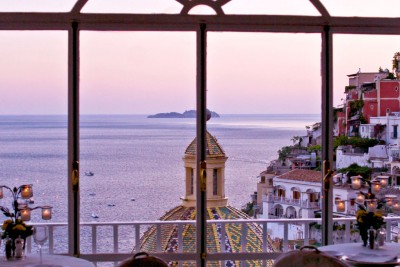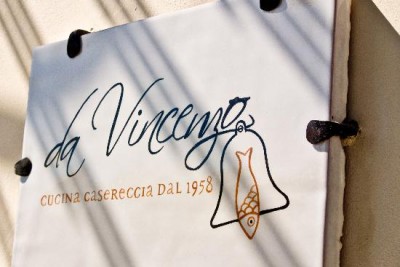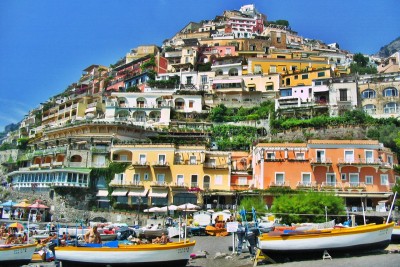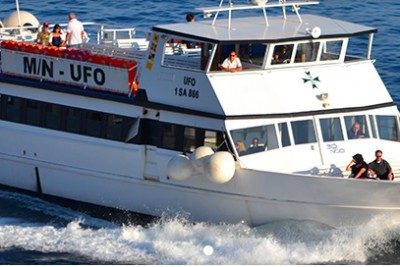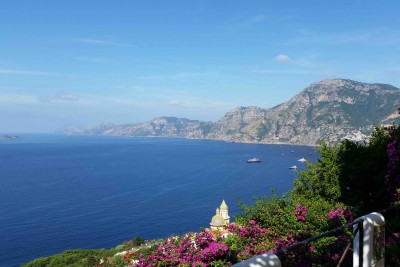Our Insider Guide to Positano
Where to go, what to visit in the town that enchanted Steinbeck





The area of Positano was among the first to be inhabited on the Amalfi Coast.
On the main road toward Amalfi there is a large cave about 200 yards below the main road towards Amalfi, which gives evidence of the prehistoric past, including a stone with an animal on it, weapons going back to 15,000 years ago, and objects used by Mesolithic hunters 10,000 years ago.
According to tradition Positano was founded by the inhabitants of Paestum, after their city was destroyed by pirates. It was therefore called Pestano or Pesitano.
Most likely, however, the name derives from the Posidii, Emperor Claudius’ freedmen who owned property in the area.
The remains of a Roman villa show that the area was already inhabited back then.
Branching off from the Coast road, viale Pasitea dips sinuously through the town.
At the bottom is Piazza dei Mulini. From there, one can take via dei Mulini, a foot path in the direction of the sea to the a small piazza with the Chiesa di Santa Maria Assunta (#1 on the map).

Founded in the 13th century, the church has the beautiful majolica dome, which is pictured in most landscapes of Positano. Under its surface lies a medieval church and below that the remains of a Roman villa.
The Collegiate had a Byzantine floor, traces of which can be found in the apse. On the main altar there is a Byzantine an oriental icon of the Black Madonna with Child (13th century), a panel in cedar believed to have arrived here by sea.

Inside, in the transept, there is a Circoncisione (Circumcision) by Fabrizio Santafede (16th century); in the apse, two niches with Maria Addolorata and a Christ (1798), a Cristo sulla croce (Christ on the Cross) (16th century); the reliquary of San Vito (1506), a great example of the Neapolitan goldsmith’s art. The lower half of the bell tower is decorated with a bas-relief (13th century) depicting imaginary animals.
The separate bell tower incorporates a medieval relief with a sea monster, fish, and a fox.

The wall and the pavement of the square in front of the church, piazza Flavio Gioia (#2), is decorated with mosaics by Neapolitan artist Mimmo Paladino.

Just next to the church are the remains of a Villa Romana (#3), an ancient Roman villa, discovered in 1758 by Carlo Weber, the archeologist in charge of the excavations of Pompeii and Herculaneum.

Local records show that the remains were found at the end of 1600 when the some ancient pieces were found and sold in Naples by the local priest in order to raise money to enlarge the church.
At least part of the villa are traced back to the first century B.C., a period when the Roman elite was building luxury summer residences around the Gulf of Naples.
Around the middle of the 1st century AD, the villa apparently underwent renovations due to the damage caused by a 62 AD earthquake. That renovation gave the villa a facelift, as evidenced by a sumptuous triclinium discovered in the crypt.
The walls were painted with motifs typical of the 4th style of Pompeiian Wall Painting.

The upper section of the walls shows a trompe l'oeil curtain with marine monsters, leaping dolphins and cherubs.

The middle section is decorated with monochromatic painted panels with garlands and a series of medallions that used to show portraits, mythological scenes and small paintings of still life and seascape.

At the time of the eruption of Mt. Vesuvius in 79 A.D, the villa was covered with a blanket of lapilli, which was then hardened by the torrential rains that followed the eruptive process and by the debris that came downstream from the Lattari mountains above the area.
The process of burial and destruction of this villa was similar to that of Herculaneum.
Mudslides must have reached the villa, filling its rooms and causing ceilings and roofs ro collapse. The plaster columns on the portico were knocked over and dragged inside the dining room and the kitchen, where the bronze kitchenware was later discovered.

The most beautiful, and valuable object found in the villa is a glazed twin-nozed oil lamp with two horseheads on the sides and decorated at the center with Medusa's head.

The lamp was probably made in the area of Salerno around the 1st century AD.
The remains of the villa are split in two sections, one right below the bell tower and the other below the body of the church.

Both sections are now part of the Museo Archeologico Roma of Positano (but with two different entrances).
In the early Middle Ages, on the ruins of the villa, an abbey was built, with two crypts and special pots to dry the bodies pf the clergy.

From the piazza of the church one quickly descends to Marina Grande (#4), the main beach, with a beautiful view of the coast.

Spiaggia Grande
To the West (toward Sorrento) is Fornillo, a smaller but quieter beach (#5).
 Fornillo
Fornillo
Arienzo is another nice beach, to the South-East of Positano (#6).

For printing our Positano Guide (facing pages) you can download the PDF by clicking HERE
For offline reading on your smartphone or tablet, you can download the PDF of our Positano Guide (single page) by clicking HERE
If you have an Android OS, you will find it in your Download app.
If you have an iPhone or an iPad, open and save it in iBook (free app).

